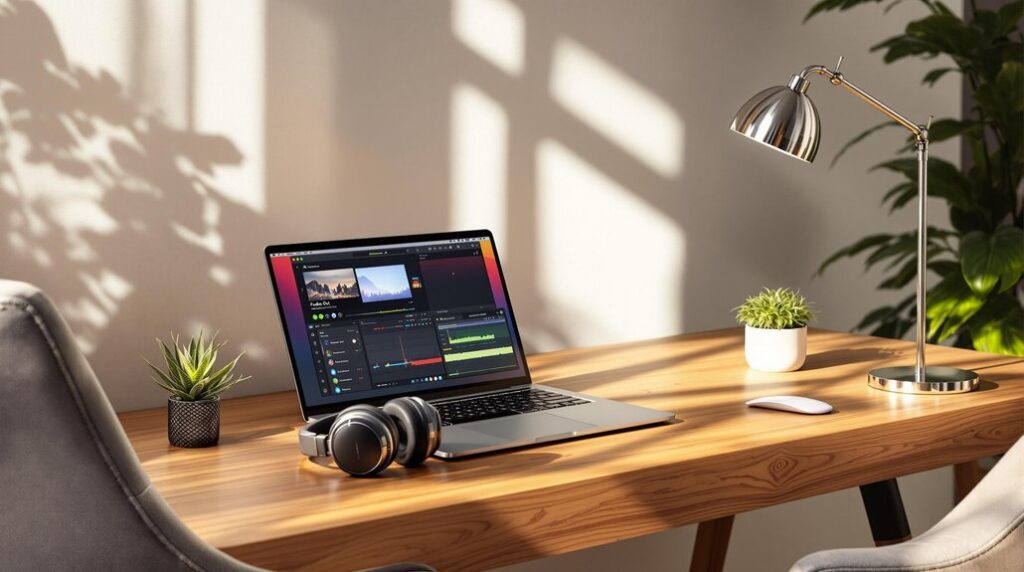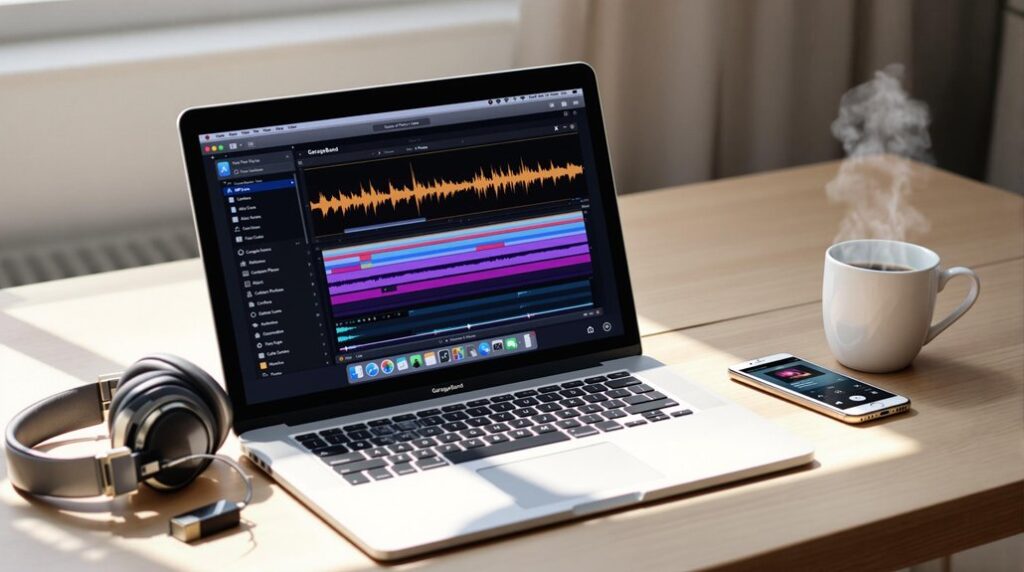Begin by preparing your GarageBand project. Guarantee a clean workspace, create a new project, and import audio files by dragging them into the software. Next, apply the pitch shift effect by selecting "AUPitch" from an empty effect slot and adjusting the Effect Blend, Smoothness, and Tightness knobs to 100%. Fine-tune the pitch with the Fine Tune slider for precise control in increments of 1/100th semitone. Once adjustments are made, click "Done" and evaluate the changes. To further explore the intricacies of pitch modulation, consider experimenting with these tools for diverse audio effects.
Key Takeaways
- Open a clean GarageBand project and import your audio file by dragging it into the workspace.
- Access an empty effect slot on the audio track and select "AUPitch" from the Audio Unit Effects menu.
- Adjust the pitch using the Effect Blend, Smoothness, Tightness knobs, and Fine Tune slider for precision.
- Use the pitch correction tool for Auto-Tune effects and click "Done" to save changes.
- Playback the track to evaluate modifications and experiment with different pitch settings as needed.
Prepare Your GarageBand Project
When preparing your GarageBand project for pitch adjustment, it is crucial to start with a clean and organized workspace. Open GarageBand and create a new project, confirming the absence of extraneous tracks by utilizing command + delete for any template remnants. Next, import the audio by locating your desired MP3 within OSX Finder, then simply drag and drop it into GarageBand's dark-grey center. The appearance of an orange waveform confirms that the audio is ready for editing and subsequent pitch adjustments. For peak focus, disable the metronome via the Control menu by unchecking the metronome option, thereby minimizing auditory distractions. To enhance the editing process, consider using Smart Controls for real-time sound quality improvements and more precise pitch adjustments. This meticulous setup guarantees a streamlined environment for precise audio manipulation, facilitating an efficient editing process for your pitch modification endeavors.
Apply the Pitch Shift Effect
Initiate the pitch modification process in GarageBand by strategically employing the Pitch Shift effect, a versatile tool for nuanced audio manipulation.
To apply this effect, navigate to an empty effect slot within your audio track and access the drop-down menu. Select "AUPitch" from the Audio Unit Effects section to integrate the pitch shifting capability into your track.
Once selected, adjust the settings by clicking on the effect image, which reveals knobs for precise control. The Pitch knob allows you to transpose audio in cents, where 100 cents equates to one half step—enabling meticulous pitch adjustments.
For a pronounced effect, set the Effect Blend, Smoothness, and Tightness knobs to 100%. This combination guarantees a robust alteration of the track's pitch characteristics. GarageBand also offers a pitch correction tool that provides Auto-Tune capabilities for vocal pitch adjustments.
Fine-Tune and Save Changes
Refine the intricacies of your audio track by utilizing GarageBand's Fine Tune slider for meticulous pitch correction. This tool allows for precision adjustments in increments of 1/100th of a semitone, guaranteeing an unparalleled level of accuracy.
Following your adjustments with the pitch slider, click "Done" to save changes, effectively exiting the editing mode. Playback your track to critically assess the impact these modifications have on the overall sound.
Should the need arise to revert any changes, the Edit tab provides swift access to readjust the pitch slider. Experimentation is encouraged; save multiple iterations of your project to explore diverse pitch effects while safeguarding the integrity of your original work.
This strategic approach guarantees a polished, professional audio output.
Frequently Asked Questions
How Do I Change the Pitch in Garageband?
To address pitch shifting in GarageBand, utilize audio effects for precise melody editing and vocal enhancement. Adjust instrument tuning and sound design through music layering. Integrate chord progression and track automation for seamless audio mixing and enhanced project coherence.
How Do I Change the Tuning on Garageband?
To change tuning in GarageBand, utilize tuning presets and adjust pitch through audio effects and instrument tuning. Key changes, note bending, vocal tuning, and MIDI settings are essential. Scale selections and tempo influences further refine your musical composition.
Does Garageband Have a Pitch Corrector?
Yes, GarageBand includes pitch correction tools, especially Flex Pitch, which enhances vocal recordings. Utilizing audio editing techniques, this software offers music production tips, plugin recommendations, and MIDI manipulation methods for creative recording ideas, mixing, and mastering.
How Do You Transpose Audio in Garageband?
Transposing audio in GarageBand involves using editing techniques within its digital audio interface. Utilize the Transpose feature for pitch shifting, enhancing sound design. GarageBand's features support creative workflows in music production, facilitating vocal tuning and precise audio manipulation.
Conclusion
To sum up, executing pitch alterations in GarageBand involves a systematic approach encompassing project preparation, application of the pitch shift effect, and meticulous fine-tuning prior to saving. This process necessitates a thorough understanding of audio manipulation techniques and the functionality of GarageBand's interface. Mastery of these steps guarantees precision in audio output, enabling users to achieve desired tonal modifications effectively. Adherence to these procedures will facilitate the production of high-quality, pitch-adjusted audio tracks, aligning with industry standards and technical expectations.




